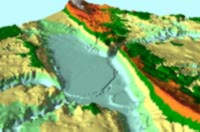Terrain Modeling with ArcView GIS

The "Terrain Modeling with ArcView GIS" series ArcUser magazine has been reformatted into individual lessons for use in the classroom or for self study. These lessons, designed for intermediate level ArcView GIS users, not only model freely available data of real-world locations but provide information on data formats and data handling strategies.
Each lesson is available as a PDF format file that can be printed online or saved locally. These files require Acrobat Reader version 4. This version is available at no charge from the Adobe Web site. Sample data and any scripts, extensions, or utilities needed to complete each exercise are listed with the lesson in zipped files.
These lessons are based on articles written by Mike Price of Esri and Dr. David Miller of the State University of New York College at Cortland.
Lesson 1: Finding Data for Modeling
Learn about the types of data available at no charge from the USGS. No data or utlities required. Download tutorial and visit the USGS EROS Data site.
Lesson 2: Acquiring and Convertin DLG-O Data
Unzip and convert 1:100,000-scale DLG files. Download tutorial. Data downloads are broken into boundaries, public lands, transportation, hydrography, hypsography_a, and hypsography_b files.
Lesson 3: Two-Dimensional Modeling
This tutorial shows how to download DLG-O data from the USGS site.
Lesson 4: Modeling in Three Dimensions
In this lesson, modify the model created in lesson 3 by creating a TIN, draping line features over the TIN, and improving the legend. Download the tutorial, use the data downloaded and converted in the previous lesson, and get the database file for enhancing the legend.
Lesson 5: Label Features Using GNIS Data
In this tutorial, learn how to use GNIS data, a label point data set to label the model used in lessons 3 and 4. Download the data and project file for this model if you did not do so in the previous lesson and get the corrected GNIS data set and the Projector! extension.
Lesson 6: DEM-based Terrain Modeling
In this tutorial, you will create hillshade, contour line, TIN, and three-dimensional themes using DEM data. An Internet connection to download data from the Cornell University site and the ArcView Spatial Analyst extension are required.
Lesson 7: Rotating Point Symbols
This tutorial uses a point symbols for geologic data and shows how to correctly orient these symbols in a view. Download the zipped file containing the sample data, geology symbol palette, and conversion table.
Lesson 8: Model SDTS Format DEM Data with Raster to Grid Utility
A utility that comes with ArcView GIS 3.2 will convert SDTS format DEM data into grid files that can be used by ArcView Spatial Analyst or ArcView 3D Analyst. An Internet connection for downloading data from the USGS EROS site and ArcView Spatial Analyst or ArcView 3D Analyst are required for this tutorial.
Lesson 9: Using 1:250,000-Scale DEM Data
Unzip, import, reproject, and merge 1:250,000-scale DEM data. Two scripts, a custom extension, an Internet connection to download files from the USGS EROS site, and ArcView Spatial Analyst 1.1 or higher are needed for this tutorial.
|
